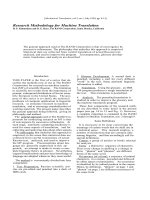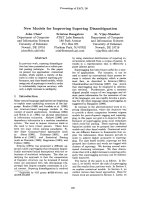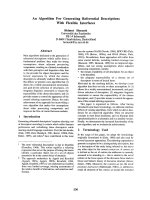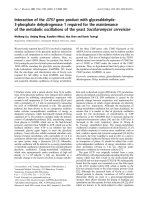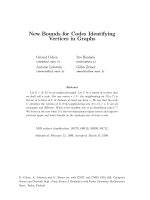Báo cáo y học: "New methodology for specific inhalation challenges with occupational agents" pdf
Bạn đang xem bản rút gọn của tài liệu. Xem và tải ngay bản đầy đủ của tài liệu tại đây (833.87 KB, 7 trang )
Caron et al. Respiratory Research 2010, 11:72
/>Open Access
RESEARCH
© 2010 Caron et al; licensee BioMed Central Ltd. This is an Open Access article distributed under the terms of the Creative Commons
Attribution License ( which permits unrestricted use, distribution, and reproduction in
any medium, provided the original work is properly cited.
Research
New methodology for specific inhalation
challenges with occupational agents
Simon Caron
1
, Jean-Christian Boileau
1
, Jean-Luc Malo*
2
and Simon Leblond
1
Abstract
Background: Inhalation challenges are used for diagnosing occupational asthma (OA). The initial methodology
consisted of a "realistic" exposure without monitoring nor controlling exposure. Our aim was to design an equipment,
called the GenaSIC, that allows the generation of various agents regardless of the formulation and to assess the
feasibility of its use in patients investigated for OA.
Results: GenaSIC can generate lactose, flour, malt, isocyanates, formaldehyde and N-butyl acetate with precise and
fairly stable concentrations. Using N-butyl-acetate as a control agent and real time measurement, we show that normal
breathing has a negligible effect on the concentration. We exposed forty-four different subjects to a control agent and/
or to a suspected occupational agent. Nineteen of the subjects were only exposed to N-butyl acetate as a control
agent without experiencing any significant irritant effect (no significant changes in spirometry thereafter). Eight
subjects who were exposed to both N-butyl acetate and formaldehyde did not show significant reactions. Seven
subjects were exposed to dry particles (flour in six instances, malt in the other) and five showed immediate asthmatic
reactions which changes in FEV1 from 20% to a maximum of 28%. Finally, ten subjects were exposed to isocyanates,
four of whom showed a positive reaction, including one subject with immediate maximum changes in FEV1 of 22%.
Conclusion: GenaSIC offers the possibility of reliable and safe exposures to dry particles, formaldehyde and
isocyanates in the investigation of OA.
Introduction
Occupational asthma (OA) is a type of asthma caused by
the workplace. The most common type of OA is the one
that occurs after a latency period and that is caused by an
acquired sensitization to an agent present in the work-
place. Because of the considerable health and socioeco-
nomic consequences [1], it is mandatory to confirm the
diagnosis with objective testing. Several means of con-
firming the diagnosis have been proposed, all of these in a
stepwise approach [2,3]. The most precise way of con-
firming OA is by exposing the worker to the suspected
agent and closely monitoring any functional and inflam-
matory changes. This can be done in the workplace [4] or
the exposure can be reproduced in a hospital laboratory
in a "realistic way" as originally proposed by Pepys [5].
Because the realistic approach can lead to erratic expo-
sures if the administered concentration or dose of the
agent is not carefully controlled [6,7], with the threat of
considerable and immediate asthmatic reactions [8],
closed-circuit apparatuses have been proposed. This type
of exposure in which the concentration of the agent can
be continuously monitored and determined during expo-
sure allows to control precisely the dose of inhaled sus-
pected occupational agent. This presents definite safety
advantages, limiting the importance of immediate reac-
tions [9]. As in non-specific inhalation challenges, the
maximum fall in FEV1 should be limited to 20 to 30%
during these tests, a threshold that does not present risk
and at which the patient does not experience intolerable
symptoms. It is more difficult to control the importance
of late reactions [9], but use of this equipment also offers
safety advantages over the realistic approach. Moreover,
contrary to immediate reactions which are abrupt, late
reactions take sufficient time to develop allowing for
pharmacological intervention to limit and efficiently treat
the asthmatic reaction.
The main limitation of existing apparatuses is that they
are incapable of generating all types of agents that can
exist as dry particles, wet aerosols and vapors. Therefore,
* Correspondence:
2
Department of Chest Medicine, Sacré-Cœur Hospital, Montreal, Canada
Full list of author information is available at the end of the article
Caron et al. Respiratory Research 2010, 11:72
/>Page 2 of 7
we designed a piece of equipment for specific inhalation
challenges with occupational agents that can allow for all
types of generation within the same instrument. We also
assessed the feasibility of its use by hereby presenting the
results of challenges (stability of concentrations, bron-
chial reactions) undergone by 44 subjects. Since one of
the main advantages of the closed-circuit apparatuses is
to be able to control with high precision the quantity of
inhaled substance, we did several quality tests on the
GenaSIC. We specifically studied its stability during the
time of a generation and also its reproducibility.
Material, Subjects and Methods
The GenaSIC (see Figure 1) is a closed-circuit aerosol
generation chamber; i.e., it enables continuous generation
of low and stable concentrations of agents, dust or aero-
sols in an airtight enclosure with controlled atmospheric
conditions. This equipment builds upon a first generation
of closed-circuit generation systems jointly developed by
the Institut de recherche Robert-Sauvé en santé et en séc-
urité du travail and the Sacré-Coeur Hospital in Montreal
in the late 1980s and early 1990s [6,7]. These devices
proved to be effective in delivering controlled doses of
dusts, vapours or isocyanates. The GenaSIC renders this
technology more versatile by merging all three generation
capabilities into a single device.
The GenaSIC is capable of aerosolizing dusts, liquids or
vapours continuously while maintaining stable concen-
trations between 0.001 mg/m
3
and 1000 mg/m
3
depend-
ing on the physical attributes of the product. The basic
generation process is as follows: the agent being gener-
ated is aerosolized by a generator - a syringe-like injector
- and brought to the desired concentration by dilution
using multiple computer-controlled flow meters. The
patient is then exposed at the chamber level where a
known and stable concentration circulates at all times.
This process is shown in Figure 2.
The GenaSIC's generation capabilities were first vali-
dated in a laboratory setting using both sampling and
direct measurement instruments. For the formaldehyde
and 1.6 HDI, the validation methodology was as follows:
for each concentration, direct measurements were taken
at fixed intervals (between one second and one minute,
depending on instrument used) for the length of the gen-
eration period. Simultaneously, five samples were taken
over the generation period to ensure an absolute measure
of mean concentration. Two different methods were used
to reduce potential errors of measurement. For N-butyl
acetate, the sampling method was performed and for lac-
tose, we used a direct measurement. To improve our
error analysis, supplemental tests were done using real
time measurement on some liquid aerosol (N-butyl ace-
tate, formaldehyde, toluene). We could therefore observe
any instant variation of concentration and investigate
possible sources of errors. Particularly, we have analyzed
the effect of breathing on the concentration in the gener-
ation chamber. We also have repeated the same set of
experiments many times during two weeks to test the
reproducibility of the GenaSIC.
Forty-four subjects who underwent specific inhalation
challenges between September 2007 and April 2009 were
included in the validation process. These subjects were all
consecutive patients for whom the cause of OA was one
or another of the occupational agents that could be gen-
erated using GenaSIC. There was therefore no selection
of patients and there was no instance of refusal. All these
subjects were investigated for possible OA with standard-
Figure 1 Key features of the SCL•GenaSIC™. Figure 2 Generation process of the SCL•GenaSIC™.
Caron et al. Respiratory Research 2010, 11:72
/>Page 3 of 7
ized procedures that included baseline spirometry [10],
responsiveness to methacholine [11] and examination of
induced sputum [12]. Specific inhalation challenges were
performed as described [13]. Briefly, baseline FEV1
should be ≥ 2 L and variability of FEV1 on the control day
should not exceed 10%. In all instances where testing was
negative after exposing the subject using the new equip-
ment (no significant changes in spirometry, responsive-
ness to metacholine and induced sputum cells), the
subject was exposed in a "realistic way" [5] for two hours
using the same suspected occupational agent. For the
realistic exposure to isocyanates, concentrations are
monitored and generally do not exceed 20 ppb. In this
study, concentrations were not monitored in the case of
the realistic exposure to other agents. The control prod-
ucts used were: 1) lactose, if the causal agent was in a dry
aerosol; 2) N-butyl acetate, if the causal agent was in an
aerosol or vapor form.
The project was accepted by the Ethics Committee of
the Sacré-Coeur Hospital and all participants signed an
informed consent.
Results
Real Time Measurement
Although the main indicator of exposition is given by the
mean concentration, it is important to ensure that the
patient is never subjected to extremely high transient
concentration of the suspected occupational agent. For
that purpose, we performed a real time measurement of
the concentration in the chamber using a ppbRAE 3000, a
device based on a photoionization detector, which can
produce a new reading every second. We measured N-
butyl acetate and toluene and formaldehyde. From the
results obtained with these substances, we could calculate
the time required to reach a relatively stable concentra-
tion and observe the effect of a patient's breathing on the
stability of the chamber concentration. At the start of a
generation, an extra amount of substance is injected into
the chamber when the syringe-like injector is moved into
position, creating a very high concentration burst. This is
illustrated in Figure 3, which represents the chamber con-
centration variation during typical runs of N-butyl ace-
tate or toluene. Before letting the patient breath the air in
the chamber, we ensured that the initial concentration
burst was over. For the liquid aerosols that we tested, the
initial concentration burst was always less then 3 min-
utes. However, in some tests, it has taken slightly longer
for the flow in the chamber to stabilize. Table 1 gives the
measured time required for the concentration to stabilize
in the chamber for five different sets of experiments:
three with N-butyl acetate and two with toluene. This
suggests that a waiting time (burn-in period) of five min-
utes is enough to reach the concentration equilibrium in
the chamber for the generation of aerosol from liquid that
vaporize well, except for very low concentrations, were a
waiting time of 10 minutes is more appropriate.
The initial concentration burst is followed by a stabili-
zation of the chamber concentration. Figure 4 presents
the data of the same two experiments as the ones
depicted in Figure 3, except that the initial concentration
burst was excluded. We can see that both the concentra-
tion of the toluene and the one for N-butyl acetate oscil-
late at a frequency close to 0.008 Hz (close to one
oscillation every two minutes). Multiple experiences
showed that the frequency of the oscillation did not
depend on the concentration of the substance, but rather
on the rate of the flow of air through the chamber. We
also performed one run with formaldehyde. In this case,
the burn-in period is approximately 100 seconds.
Mean concentrations
The GenaSIC's generation capabilities were validated in a
laboratory setting by sampling methods and/or direct
measurement instruments. Table 2 presents detailed
results of measurements taken during validation runs for
N-butyl acetate, formaldehyde, 1.6 HDI and lactose. The
main objective was to see if the concentration was similar
at the start (after the burn-in period), in the middle and at
the end of the generation.
Direct measurement during a 1.5-hour generation of
N-butyl acetate (excluding the burn-in period) was used
to calculate the average concentration for periods of five
minutes. This gave 18 averages where the difference
between the largest and smallest value was less then 3%
(the mean of the averages was 52.1 mg/m
3
with standard
deviation of 0.3 mg/m
3
, the maximum value was 52.7 mg/
m
3
and the minimum value was 51.4 mg/m
3
). This implies
that the average concentration over an interval of a few
minutes is relatively constant any time in a generation.
Specific Inhalation Challenges
Table 2 gives information on the targeted and obtained
concentrations during the generation of lactose, flour and
isocyanates. All products were generated from vials in
which the available concentration was 50 mg/m
3
. The
Figure 3 Chamber concentration variation during typical runs of
N-butyl acetate and toluene.
Caron et al. Respiratory Research 2010, 11:72
/>Page 4 of 7
obtained concentrations were close to the targeted con-
centrations with small variability.
The GenaSIC apparatus was used for exposing 44 dif-
ferent subjects referred for possible OA (Table 3). In 37
instances, N-butyl acetate was used as the control agent.
In 19 of these 37 subjects, the test consisted of a sole
exposure to N-butyl acetate for 30 minutes. These sub-
jects were subsequently exposed to potential causal
agents (acrylates, isocyanates, etc.) using other method-
ologies if the tests were carried out in the hospital labora-
tory or in the workplace. In all other instances (n = 18),
exposure to N-butyl acetate preceded exposure to formal-
dehyde (n = 8) or isocyanate (n = 10) with the GenaSIC.
Eight different subjects were exposed to formaldehyde
incrementally for 4, 30 and 120 minute periods. All these
tests proved negative; i.e., with no significant (<10%)
changes in FEV1 in the following minutes and hours. Ten
other subjects were exposed to isocyanates (TDI in two
instances and HDI in eight others). In six subjects, the
test proved negative for up to two hours of exposure with
GenaSIC and also, for two hours in a realistic way on a
subsequent day. Four subjects had a positive reaction
(Table 3); one immediate (maximum fall in FEV1 of 22%)
and two late reactions (maximum falls in FEV1 of 17%
and 51%). In the other positive test, the subject had sig-
nificant changes in reactivity to methacholine and
marked increases in total cell count and % of neutrophils
after being exposed for two hours to HDI. Seven other
subjects were exposed to dry particles; six being exposed
to wheat flour and one to malt powder. Lactose that was
aerosolized for 30 minutes at a mean concentration of
3.25 mg/m
3
(Table 3) represented the control exposure in
all these subjects. Exposure to flour varied from 1 to 120
minutes at a mean concentration of 4.36 mg/m
3
and five
of the six tests resulted in immediate falls in FEV1 that
varied from 21 to 28% (Table 3). In the other negative
instance, subsequent exposure to flour in a realistic way
for 2 hours did not cause any significant changes in FEV1.
There was one subject who reacted to malt powder,
developing a hypersensitivity-pneumonitis-like reaction
(with fever, leucocytosis and a maximum fall in forced
vital capacity of 12%).
Discussion
The purpose of specific inhalation challenges in a hospi-
tal laboratory is to reproduce a possible asthmatic reac-
tion by exposing the worker to a potential causal agent
present at work, by generating stable and safe concentra-
tions of the product and eliciting an asthmatic reaction
for which the fall in FEV1 is significant and acceptable (20
to 30% change in FEV1). The development of exposure
apparatuses fulfilled these criteria.
We have previously shown that dry particles can be
generated at lower and more constant concentrations
with a generator than with the realistic approach in which
a worker is simply asked to tip dry particles in a ventilated
cubicle [6]. In the case of isocyanates, we also showed
that the variation of concentrations during the exposure
with a generator was less than what is documented in a
ventilated cubicle [7]. Albeit for the advantage of offering
the possibility of generating dry particles, vapor and aero-
sols with the same equipment, the new generator allows
for exposing workers to low and stable concentrations. In
the case of dry particles (flour and malt), the variability of
Table 1: Time required to reach a steady-state concentration in the chamber
Substance Targeted concentration (mg/m3) Number of runs Required burn-in time (sec)
Mean SD Max Min
n-butyl acetate 8.5 18 218 104 477 101
65 20 129 9 150 111
370 17 120 6 132 108
toluene 10 6 153 74 300 111
150 6 126 12 150 118
Figure 4 Concentration of N-butyl acetate and toluene after sta-
bilization of the chamber.
Caron et al. Respiratory Research 2010, 11:72
/>Page 5 of 7
concentrations was low (see Table 2). In the case of isocy-
anates, the variability of concentrations that we docu-
mented with the GenaSIC generator used in the current
study (mean ± SD of 14.0 ± 3.6 ppb) is comparable to
what we obtained with a previous generator (mean ± SD
= 11.2 ± 3.9 ppb, range 4-24 ppb) [7].
The GenaSIC has several other advantages over the
previous generation of close-circuit equipment. First,
since the equipment is now commercialized, it is more
easily accessible to the community interested in objective
confirmation of occupational asthma and all scientific
aspects related to human exposure to dry particles, vapor
and aerosols. Secondly, the GenaSIC is less cumbersome
than the previously described generators, and easier to
clean. The smaller size of the equipment facilitates han-
dling and transport. Also, the generation sequences are
automated, which greatly reduces intervention on the
part of technicians responsible for the challenges. The
technician's target concentration is automatically set by
the apparatus. Therefore, the method of exposure might
be repeatable from one center to another using the same
equipment. A more generalized use can greatly improve
expertise and exchanges. The main limitation of the
GenaSIC is, for the time being, the fact that it can gener-
ate only a limited quantity of occupational agents. Each
new agent must be validated before exposure. However,
flour and isocyanates that represent the most frequent
causes of OA can be generated. The GenaSIC is also a
highly technical device, requiring trained personnel on
the operation and maintenance of device as well as clini-
Table 2: Targeted and achieved concentrations of generated products during run-in testing
Run-in testing
Product Targeted concentration Obtained concentration
Mean Median SD Max Min
Concentration validated by sampling
N-butyl acetate 150 mg/m
3
148 150 5 150 140
N-butyl acetate 250 mg/m
3
242 240 4 250 240
N-butyl acetate 320 mg/m
3
322 320 8 330 310
Formaldehyde 0.65 mg/m
3
0.65 0.66 0.05 0.7 0.56
Formaldehyde 1.0 mg/m
3
1.07 1.07 0.08 1.2 0.98
Formaldehyde 1.7 mg/m
3
1.69 1.65 0.08 1.82 1.64
Isocyanates (1.6-HDI) 0.05 mg/m
3
0.05 0.06 0.01 0.07 0.03
Isocyanates (1.6-HDI) 0.10 mg/m
3
0.09 0.09 0.01 0.11 0.08
Concentration validated by direct measurement instrument
Formaldehyde 0.65 mg/m
3
0.63 0.63 0.08 0.87 0.36
Formaldehyde 1.0 mg/m
3
1.07 1.06 0.1 1.94 0.74
Formaldehyde 1.7 mg/m
3
1.43 1.43 0.04 1.58 1.31
Isocyanates (1.6-HDI) 7.2 ppb 6.4 7.0 0.1 7.0 5.0
Isocyanates (1.6-HDI) 14.6 ppb 12.6 13.0 0.5 13.0 12.0
Lactose <10 mg/m
3
7.9 7.9 0.9 11.50 5.20
Challenges
Lactose <5 mg/m
3
18 3.25 3.05 0.87 5.45 1.75
Flour and malt <5 mg/m
3
38 4.36 4.5 1.14 7.0 2.0
Isocyanates <20 ppb 29 13.98 15.0 3.6 22.5 7.0
The mean of all samples for a given concentration is used as the calibration point. Measurement equipment was calibrated independently for
lactose.
Caron et al. Respiratory Research 2010, 11:72
/>Page 6 of 7
cal procedures. This limits its accessibility to centers hav-
ing sufficient resources for such equipment. Use by
untrained personnel can translate in malfunctions and
improper results. Training for clinicians, technicians and
medical engineers is offered with the device to mitigate
this limitation.
Both cost (regional pricing for the GenaSIC can be
obtained by contacting SCL Medtech through their web-
site:
) and handling time of
the GenaSIC could also be seen as limitations to the
widespread usage of such equipment. Indeed, the Gena-
SIC represents a significant investment and handling of
the device before (preparation) and after (cleaning)
patient exposure is somewhat time consuming. We how-
ever feel that in both cases these represent a significant
improvement on realistic exposure methods. The costs of
setting up a realistic exposure environment are those of
the cubicle and exhaust system, which are significant and
often unfeasible in hospital laboratories. The GenaSIC
removes the need for a dedicated exhaust system because
of integrated filters on the elimination line. Preparation of
the GenaSIC for a specific challenge is estimated at 30
minutes, which is slightly superior to cubicle preparation.
Cleaning of the GenaSIC requires 15 minutes of manipu-
lation and 25 minutes of automated cleaning. Depending
on the substance generated, this can be significantly less
than the time required to clean a cubicle. Finally, the
GenaSIC can also offer reduced costs when compared to
custom made close-circuit equipments because of its
compliance to electrical standards and its use of off-the-
shelves components [6,7,14].
The main risk of specific inhalation challenges is
related to the magnitude of the immediate reaction that
occurs in the period up to 20 minutes following cessation
of exposure [5] Therefore, it is important to control the
exposure so as to obtain a progressive change in airway
obstruction that does not exceed 30%, similar to what is
generally aimed for in non-specific challenges. In a previ-
ous study, we showed that the use of generators resulted
in a significantly reduced occurrence of exaggerated
immediate reactions defined as changes in FEV1 that
exceed 30% by comparison with the realistic approach
[9]. In our study, we were able to obtain such acceptable
reactions in all instances of immediate reactions. Exag-
gerated late reactions can still occur and although the risk
can be reduced with generators, it was not significantly so
in a previous study [9] and in the current study in which a
late reaction with a fall of 51% in FEV1 occurred. These
reactions are more difficult to predict. However, since
they occur progressively over three to four hours, they are
generally easily amenable to treatment. It is interesting to
note that in the case of negative reactions using the Gena-
SIC methodology, subjects were also exposed in a realis-
tic way. No subject showed asthmatic reactions with the
Table 3: Characteristics of subjects with positive reactions
No. Sex Age (yrs) FEV1 (% pred) PC20 (mg/ml) Agent Duration of
exposure (min)
Reaction
1 M 33 107 4.4 HDI 120 changes in PC20 and
sputum cells
2 M 40 86 >32 malt 120 hypersensitivity-
pneumonitis-like
3 M 27 83 0.06 wheat
flour
60 immediate reaction; max.
fall in FEV1: 24%
4 M 57 70 ND HDI 120 late reaction; max. fall in
FEV1: 27%
5 M 33 95 0.5 HDI 30 immediate reaction; max.
fall in FEV1: 22%
6 M 49 90 0.5 wheat
flour
90 immediate reaction; max.
fall in FEV1: 27%
7 M 36 97 1.3 wheat
flour
2.5 immediate reaction; max.
fall in FEV1: 21%
8 M 26 101 1.3 wheat
flour
1 immediate reaction; max.
fall in FEV1: 20%
9 M 48 91 1.5 wheat
flour
2 immediate reaction; max.
fall in FEV1: 28%
10 M 44 100 0.4 TDI 20 late reactions; max. fall in
FEV1: 51%
FEV1: forced expiratory volume-one second; PC20: concentration of methacholine causing a fall of 20% in FEV1
Caron et al. Respiratory Research 2010, 11:72
/>Page 7 of 7
realistic approach in which concentrations could only be
monitored in the case of isocyanates. It has been shown
that exposure in a realistic way results in higher and more
variable concentrations than by using closed-circuit
instruments [6,7]. Therefore, there were no instances of
false negative reactions.
We need to validate the results of this study in a greater
number of subjects by exposure to other potential occu-
pational agents that exist as dry particles, vapor and wet
aerosol. As mentioned above, expanding the use of such
equipment may greatly contribute to a more precise diag-
nosis of OA, minimizing potential risks of unexpected
asthmatic reactions.
List of abbreviations
FEV1: forced-expiratory-volume one second; HDI: hex-
amethylene-diisocyanate; OA: occupational asthma;
PC20: concentration of methacholine causing a fall of
20% in FEV1; TDI: toluene-diisocyanate.
Competing interests
JLM holds no intellectual property and no commercial interest in the GenaSIC
instrument. These are owned by SCL Medtech. SL and SC work for SCL
Medtech (see title page).
This research work was supported by public organizations: The Canadian Insti-
tutes of Health Research (UOP - 77850 and the Center for Asthma in the Work-
place, CDA66154) and the Ministère du Développement Économique, de
l'Innovation et de l'Exportation du Québec (VT05-039) (see acknowledge-
ments).
This work was not supported by the tobacco industry.
Authors' contributions
SC was responsible for equipment and technical aspects. SB contributed to the
study design, administrative duties and writing of the manuscript. JCB is a
medical research student who contributed to data collection related to the
equipment. JLM was responsible for collecting clinical data and writing of the
manuscript. All authors have read and approved the final manuscript.
Acknowledgements
The authors want to thank the responsible authorities of the IRSST who offered
expertise and advice for developing the GenaSIC; in particular, Mr Yves Clout-
ier. They also thank the physicians and technicians of the Sacré-Coeur Hospital
who were responsible for the supervision of the tests. This work was funded by
The Canadian Institutes of Health Research (UOP - 77850 and the Center for
Asthma in the Workplace, CDA66154) and the Ministère du Développement
économique, de l'Innovation et de l'Exportation du Québec (VT05-039).
Author Details
1
SCL Medtech Inc. Montreal, Canada and
2
Department of Chest Medicine,
Sacré-Cœur Hospital, Montreal, Canada
References
1. Vandenplas O, Toren K, Blanc P: Health and socioeconomic impact of
work-related asthma. Eur Respir J 2003, 22:689-697.
2. Chan-Yeung M, Malo JL: Occupational asthma. N Engl J Med 1995,
333:107-112.
3. Bernstein DI, Campo P, Baur X: Clinical Assessment and Management of
Occupational Asthma. In Asthma in the workplace 3rd edition. Edited by:
Bernstein IL, Chan-Yeung M, Malo JL, Bernstein DI. Taylor & Francis., New
York; 2006:pp161-178.
4. Rioux JP, Malo JL, L'Archevêque J, Rabhi K, Labrecque M: Workplace
specific challenges as a contribution to the diagnosis of occupational
asthma. Eur Respir J 2008, 32:997-1003.
5. Pepys J, Hutchcroft BJ: Bronchial provocation tests in etiologic diagnosis
and analysis of asthma. Am Rev Respir Dis 1975, 112:829-59.
6. Cloutier Y, Lagier F, Lemieux R, Blais MC, St-Arnaud C, Cartier A, Malo JL:
New methodology for specific inhalation challenges with occupational
agents in powder form. Eur Respir J 1989, 2:769-77.
7. Vandenplas O, Malo JL, Cartier A, Perreault G, Cloutier Y: Closed-circuit
methodology for inhalation challenge test with isocyanates. Am Rev
Respir Dis 1992, 145:582-87.
8. Cartier A, Malo JL, Dolovich J: Occupational asthma in nurses handling
psyllium. Clin Allergy 1987, 17:1-6.
9. Malo JL, Cartier A, Lemière C, Desjardins A, Labrecque M, L'Archevêque J,
Perrault G, Lesage J, Cloutier Y: Exaggerated bronchoconstriction due to
inhalation challenges with occupational agents. Eur Respir J 2004,
23:300-303.
10. American Thoracic Society: Standardization of spirometry. Am J Respir
Crit Care Med 1995, 152:1107-1136.
11. American Thoracic Society: Guidelines for methacholine and exercise
challenge testing. Am J Respir Crit Care Med 1999, 161:309-329.
12. Pizzichini E, Pizzichini MMM, Efthimiadis A, Evans S, Morris MM, Squillace
D, Gleich GJ, Dolovich J, Hargreave FE: Indices of airway inflammation in
induced sputum: reproducibility and validity of cell and fluid-phase
measurements. Am J Respir Crit Care Med 1996, 154:308-317.
13. Vandenplas O, Cartier A, Malo JL: Occupational Challenge Tests. Edited
by: Bernstein IL, Chan-Yeung M, Malo JL, Bernstein DI. Taylor & Francis,
New York; 2006:227-252.
14. Choudat D, Fabriès JF, Martin JC, Villette C, Tabka F, Dessanges JF, Dall Ava
J, Conso F: Quantification of the dose of inhaled flour: relation with
nonspecific bronchial and immunological reactivities. Eur Respir J 1999,
14:328-334.
doi: 10.1186/1465-9921-11-72
Cite this article as: Caron et al., New methodology for specific inhalation
challenges with occupational agents Respiratory Research 2010, 11:72
Received: 9 April 2010 Accepted: 9 June 2010
Published: 9 June 2010
This article is available from: 2010 Caron et al; licensee BioMed Central Ltd. This is an Open Access article distributed under the terms of the Creative Commons Attribution License ( ), which permits unrestricted use, distribution, and reproduction in any medium, provided the original work is properly cited.Respiratory Research 2010, 11:72

